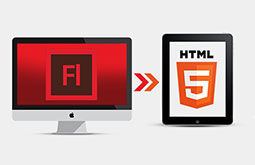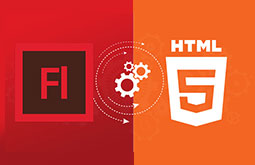Main Reasons for the Drift of eLearning From Flash to HTML5
For nearly over two decades, Adobe Flash had been the quintessential tool for eLearning course designers to develop text-heavy eLearning content, multimedia elements, and a nascent version of ‘gamification’. Flash was the ultimate choice owing to its powerful technology that transformed interactive content, pushing other formats like RealAudio, RealVideo, etc., forever.
However, with the recent paradigm shift in the realms of eLearning and creative animations, Flash has been outsmarted by JavaScript and HTML5 technologies that have taken interactivity to the next level, which has made so many developers migrate Flash-based eLearning courses to HTML5. Maybe the slow death of Flash was imminent, and that’s why Adobe decided to finally pull the plug on the ‘once-famous’ and ‘happening’ technology of the 2000s!
So today, in this blog, let’s find out what exactly happened to Flash, what kind of accessibility and modernity HTML5 brings to eLearning, and why it is so beneficial to convert Flash to HTML5. Let’s start!

What’s the issue with Flash?
So what happened to Flash? It all started back in 2005, when the year saw its gradual waning. The first blow came from Apple developers who realized Flash consumes excessive battery life, which was detrimental to their newly launched iPhone. Thus, Apple stopped supporting Flash on its devices. YouTube quickly followed suit and adapted HTML5, the most common web language currently.
Eventually, Google entirely stopped its compatibility with Flash-based content due to its unsuitability for most browsers and made HTML5 the by-default display option for web content. Thus, several companies that once integrated Flash into their sites, switched to HTML5.
And finally, in 2020, Adobe announced that it was phasing out Flash, making it non-existent. This paved the way for several software and ITES companies to adopt newer technologies. Especially those in the eLearning sector who had to reach the masses with its multimedia-based online courses. As most of the authoring tools support HTML5 output, the only option that remains for online course developers is to convert to HTML5.
Why Flash to HTML5 conversion is the best for eLearning courses
As flash has almost waned away because of many pitfalls, HTML5 is speedily emerging as the best alternative. It’s capability to play animation, 2D & 3D graphics, videos and audio etc. without any plugins as well as the provisions of offline storage and hardware access that has contributed to its increasing preference.
Now flash to html5 conversion is even recommended in case of eLearning and professionals companies are receiving a lot of inquiries for the conversion of HTML from flash. There are three main reasons for this.
-
The Bring-Your-Own-Device (BYOD) trend is on the rise.
We typically use 3-4 devices daily and we switch between these devices while doing a task thus completing it through multiple devices. Therefore it is important that the content is available on all the devices. The scenario remains the same with eLearning. We need a technology that once, when built, can be delivered everywhere and HTML5 meets this requirement.
-
Investment getting locked
Businesses are increasingly seeking the services of digital conversion companies. With this conversion, the eLearning courses that were first built on Flash are now expected to work smoothly on different devices. Flash-based courses may work effectively on desktops only and in such a scenario, conversion of flash to hyper text mark-up language unchains certain part of your investment.
-
Assuring long-term cost-effectiveness
As HTML5 is the preferred standard, it is now being integrated in all popular browsers. Training and development companies are now very keen about resources being delivered on a wide variety of devices and soon you may get the courses on Google Glass and Android wear devices.
-
Integrating new technology
The eLearning world has started opting for on a large scale after using Flash for two decades or so. The eLearning industry has made tremendous improvements over these years to cater to the needs of the constantly-evolving corporate landscape and to address training requirements in an appropriate manner. With Flash’s inability to adapt to the demands of the modern technological advancements, HTML5, which is an upgraded version of HTML, has emerged as the most preferred technology for Elearning platforms to deliver content. Importantly, HTML5 is not only easy to use, but it also works well with newer technologies.
-
Ensuring compatibility across multiple browsers
With Flash, users would need plug-ins whereas with HTML5, users do not need plugins. Flash does not exhibit SEO-friendly characteristics to a great extent, but users find HTML5 to be extremely user-friendly. Secondly, HTML5 is known for its flexibility and it can be used across old as well as new browsers. On the other hand, Flash does not demonstrate multi-browser compatibility.
-
Enabling learning across multiple devices
When Flash dominated the content delivery landscape, mobile communication technologies did not make their entry into the market. Back then, people only used desktops and were not introduced to smartphones or iPads. Flash files were very much compatible with desktops. However, as the “smart” revolution touched people’s lives and more and more people started using mobile phones to access digital content, Elearning companies started developing HTML5-based mobile-friendly platforms for users while ensuring that the content is interactive and engaging. Flash-based content is not mobile-friendly, which is another reason why you should consider shifting to HTML5 based, interactive content delivery systems.
-
Saving battery power
Modern devices are not at all compatible with Internet Explorer or other old browsers. One the other hand, Flash is compatible with only old browsers and it does not function on new browsers. No wonder why businesses are getting all of their Flash content converted to their HTML5 versions. Flash utilizes heavy processes and exhausts battery capacity very fast. HTML5, on the other hand, is a power saving option, which particularly benefits remote employees who are dependent on their mobile devices for performance, training, and connectivity.
-
Designing engaging learning content
For years, the Flash technology has been predominantly used to watch videos or to play games online. While HTML5 demonstrates the same functionality, it is much more sophisticated than Flash. With HTML5 –based content, learners are able to get a rich, interactive, multimedia-based experience and in this, in turn, leads to better learning, engagement, and higher retention.
-
Eliminating security concerns
Flash has been found to be associated with potential security flaws. Steve Jobs blamed Flash for the crashing of Mac computers. And with Adobe discontinuing all its support for Flash by this year, no security updates or support for Flash would remain available for end-users. And it might take significant time for you to convert your Flash content into HTML5 depending on the volume of the courses that you may need to convert. Fortunately, Adobe is collaborating with Mozilla, Facebook, Alphabet, and Microsoft to help their users make a smooth transition. If you start now, you will have some time left to get all your Flash files converted into HTML5 smoothly within the next few months.
Conclusion
With all these factors having their individual importance, you should plan your investments now so as to include a budget for Flash to HTML5 conversion services. We are a premium provider of Flash to HTML5 conversion services and we have been helping companies with professional support over the past several years. To get more relevant and updated information about transforming your Flash-based Elearning content into HTML5, keep following us.




